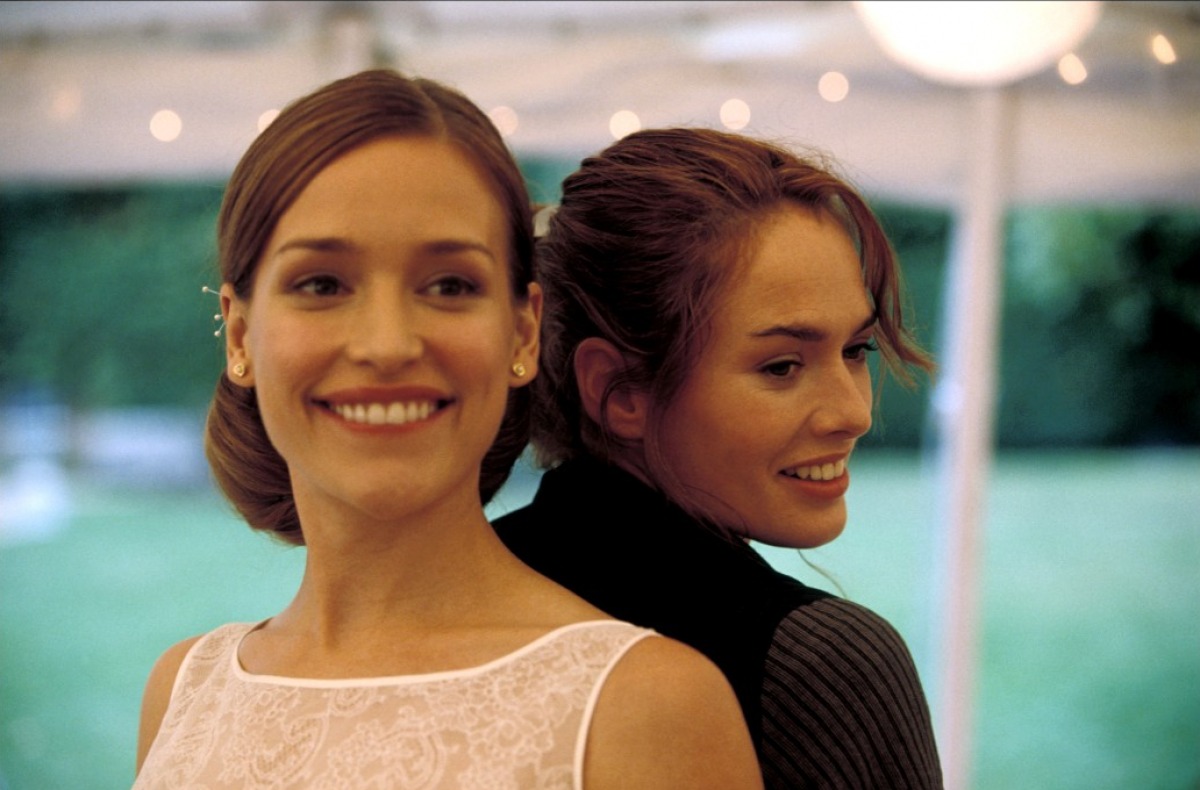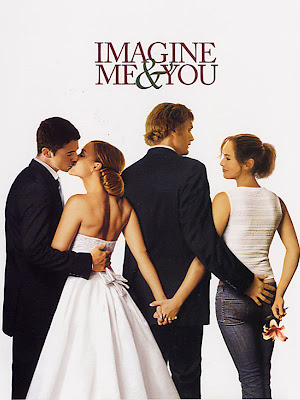This guest post written by Sara Century appears as part of our theme week on Bisexual Representation.
Okay, stop me if you’ve heard this one before. A “brassy, brave” lesbian character starts hanging around with a classically femme woman, usually for work related reasons. We assume the femme woman is straight or bisexual, as she is in a relationship with a man, be it husband or boyfriend, or, most commonly, fiancé. The woman who is engaged or married or otherwise in a long-term relationship is dissatisfied with her life, and she starts flirting with the lesbian character pretty hard, usually by praising her “bravery.” This is fair. We lesbians are a brave people. She at some point discloses that she isn’t happy in her heterosexual relationship, and that is all the lesbian character needs to go full tilt into trying to break that relationship right the hell up. Okay, once again; we’ve all been there. I’m not here to judge.
The lesbian character used to be super good at focusing on only work all of the time, but as the plot carries on, she becomes less good at focusing on work because she has a huge crush. The boyfriend is always the worst character, and their personality settings are either “well-meaning but useless” or “abusive.” Either way, they either don’t like women, view women as possessions, fail to understand women, and/or are suffering from a debilitating inferiority complex centered around their inability to understand women — often all of the above. The wife or girlfriend is almost always equally free of complexity, but is usually a lot more likable than their partner. Because it would be impossible not to be. The most likable character is usually the lesbian, but, as said, it’s not too difficult to be the most likable character in these films. The woman breaks off her engagement or what have you, performs some fairly minimal romantic gesture towards the lesbian, and then they end up together. Queue up some outro music that sounds like the Indigo Girls in 2016 and roll the credits; we’ve got a movie.
This is the basic love story or entire plot of I Can’t Think Straight, The World Unseen, Elena Undone, My Little Friend, The Four-Faced Liar, Imagine Me & You, The Gymnast, When Night is Falling, Kiss Me, and It’s in the Water, to name but a few.
For a great many years in film, the trope was two women living secluded, often quite literally on the fringes of society, with their “perverse” love affair broken up by some strapping young man and/or Richard Burton, in movies like Night of the Iguana, The Fox, Les Biches, and so on, and so forth. The woman’s bisexuality is absolved by her romance with a male character, while typically the lesbian character dies to make room for her girlfriend’s life as a straight woman. Or, in the case of The Fox, the lesbian is – wait for it – CRUSHED. By a TREE. An actual TREE.
Queer filmmakers and filmgoers alike were incredibly tired of that story by the late 1980s, so around that time, queer women started making their own movies about queer women, which is good, but then we started to see the inverse of said bisexual erasure trope, which is bad. The problem with inverting a trope is that it’s still a trope, and it’s still problematic. As the bisexuality of a character is erased in the male equivalent of this plot, so is the bisexuality of many characters erased, often by lesbian filmmakers, utilizing the same basic plot to do so. Either way, men are given way too much power in these stories, and the bisexual character is given far too little. By being abusive or at best useless lovers, the overall implication here is that the bisexuality of a female character is inspired by the male character. Where is the bisexual character’s free will? In fact, where is her bisexuality?
All of these films have one thing in common, which is that the sexuality of the character exists to cause strife between the straight man and the lesbian woman that pursues them, and always ends up siding one way or the other. The choice of whether or not to pursue a relationship with a woman is hampered either by consideration of the man’s feelings or consideration of social mores, but seldom if ever is it because the woman is genuinely attracted to the man. Similarly to the classic films where the bisexual character’s queerness is submerged beneath the revelation that she was simply manipulated by the older, more confident lesbian, so then is the desire to be in a hetero relationship blamed on social anxiety rather than the character herself having a genuine attraction to both women and men.
The woman in the hetero relationship tries to stay in her relationship despite a complete lack of interest in her lover. In films like Elena Undone (written and directed by Nicole Conn), we have extended scenes of a married woman swearing to her lesbian lover that she refuses to let her husband touch her despite living in the same house as him. I’m not saying that’s a bad thing because that guy is definitely a jerk, but why is the fact that she doesn’t have sex with him so relevant to the lesbian character? She’s still married to him, still lives with him, and is still dedicated to staying with him, so, honestly, they might as well. But the bisexual characters in these movies are always 100% attracted to the lesbian and 0% attracted to the man they’re in a relationship with. I’m not saying this has never happened, I’m just wondering why it’s such a common and prevailing plot point in so many films. The woman is definitely not a bisexual, it turns out according to these films, because she’s only attracted to just this one woman. Forever. For all eternity. For way after the credits roll. It’s so heteronormative and so immediately claustrophobic that it’s hard to see the difference between the queer relationship and the straight one. How much of a love story is it, really? These films have a tendency to end right around the time when the two women actually hook up, so we tend not to find out if we ever actually liked them as a couple.
To my mind, these stories imply, “Well, it makes sense that the main character is interested in women now, her boyfriend was a dolt, and her girlfriend is amazing.” I want to talk about what that says to audiences. You don’t have to have an oafish boyfriend first in order to be lesbian or bisexual. That’s not how the world works. I need to be clear that women don’t date each other because men suck. Women date each other because they’re attracted to each other. For the life of me, I can never understand why these stories about two women in love are centralized around men, or how or why men appear as the focal point in this way in so many films about bisexual women, nor that the woman’s ability to enter a loving relationship with a woman must exist alongside her discovery of herself as 100% lesbian. I’m not saying that it’s never happened in real life, I’m saying that this specific triangle exists in a sweeping percentage of queer-made films. These films have had the lasting effect of robbing queer women, particularly bisexual women, of their autonomy by suggesting that a bisexual “becomes gay” when the men in her life are THE WORST. There is no equivalent for this story for gay or bisexual male characters in film. For the most part, gay male characters aren’t gay because they were previously in violent or disappointing relationships with women.
The point is, you don’t have to be 100% straight or gay to enter into a stable and loving relationship. A character’s ability to love should not be gauged by their level of attraction to either gender. Neither straight men nor lesbians should expect a bisexual partner to conform in a way that erases their own sexual identity, be it in film or in real life. If they do, then they are not seeing their partner for who they are, and the story will not have a happy ending.
I’m not dismissing the quality of the films I’m mentioning here. Kiss Me (written and directed by Alexandra-Therese Keining) is one of my favorite queer movies ever; this story can be told well. Also, some of the films are based on real-life stories, and real life doesn’t care if it’s a trope or not, it’s just going to keep on keeping on. However, if I’m going to discuss bisexual erasure as a lesbian and as a film critic, I would say that the bisexual representation by many straight male and lesbian filmmakers unfortunately tends to say approximately the same thing about bisexuality, which is that it doesn’t exist.
See also at Bitch Flicks:
10 Reasons to Watch (and Love!) Imagine Me & You
Sara Century is a multimedia performance artist, and you can follow her work at saracentury.wordpress.com.







